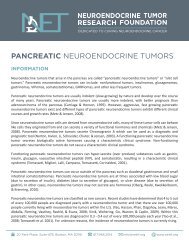PANCREATIC NEUROENDOCRINE TUMORS
You also want an ePaper? Increase the reach of your titles
YUMPU automatically turns print PDFs into web optimized ePapers that Google loves.
SYMPTOMS AND SIDE EFFECTS<br />
Pancreatic neuroendocrine tumors can cause life-threatening symptoms from both hormone hypersecretion<br />
(over production) as well as tumor growth and invasion. They may also be asymptomatic, however: as the tumors<br />
grow they can cause obstructive symptoms or symptoms from growth and invasion of surrounding tissue.<br />
Obstructive Symptoms<br />
Individuals with pancreatic neuroendocrine tumors may experience symptoms such as abdominal pain, nausea,<br />
and vomiting, even though diagnostic scanning shows nothing. Many individuals diagnosed with liver metastases<br />
have reported having undiagnosed abdominal pain for several years prior to their diagnosis.<br />
Carcinoid Syndrome<br />
Pancreatic neuroendocrine tumors can secrete a variety of hormones which can cause many clinical symptoms<br />
such as flushing and diarrhea. Symptoms occurring together may be classified as a syndrome.<br />
Typical Carcinoid Syndrome<br />
Typical Carcinoid Syndrome is the most common form of Carcinoid Syndrome and is most often caused by<br />
midgut carcinoids that have metastasized to the liver. Excess serotonin is the hormone most frequently related<br />
to Carcinoid Syndrome. The syndrome is characterized by brief episodes of flushing, diarrhea, cough, wheezing,<br />
shortness of breath, heart disease, and in rare cases, pellagra. Flushing and diarrhea are the two main symptoms<br />
that are associated with Carcinoid Syndrome. Diarrhea can be mild to severe which may lead to weight loss and<br />
life style changes. The flushing may be light pink to a deep red and occurs in the face and in the nipple-line. It<br />
may be triggered by stress, alcohol, exercise and certain types of foods.<br />
Carcinoid Crisis<br />
Individuals with Carcinoid Syndrome can also experience Carcinoid Crisis which can occur spontaneously or be<br />
stress induced. A Carcinoid Crisis can be a life-threatening event that requires careful monitoring. Symptoms of<br />
a Carcinoid Crisis may include severe hypotension or hypertension, irregular and/or rapid heartbeat, wheezing,<br />
prolonged flushing, severe dyspnea (shortness of breath), and peripheral cyanosis (lack of oxygenated blood).<br />
Carcinoid Heart Disease<br />
Pancreatic neuroendocrine tumors can secrete a variety of hormones and vasoactive substances such as<br />
serotonin. When these substances are released from liver metastases, the right side of the heart is exposed to<br />
them. As a result, patients may experience Carcinoid Heart Disease characterized by plaque lesions in the right<br />
side of the heart. Carcinoid Heart Disease can cause right-sided heart failure (Moller, Connolly, Rubin, Seward,<br />
Modesto, & Pellikka, 2003). Carcinoid Heart Disease is most common on the right side of the heart but can<br />
also occur on the left side (Tomassetti, Migliori, Lalli, Campana, Tomasetti, Cordinaldesi, 2001). While serotonin<br />
production is related to development of Carcinoid Heart Disease, there is evidence of increased cardiac lesions<br />
during somatostatin analog therapy (Moller et al., 2003). All neuroendocrine tumor patients should be familiar<br />
with Carcinoid Heart Disease and discuss appropriate monitoring with their physician.<br />
20 Park Plaza, Suite 478, Boston, MA 02116 617.948.2514 info@netrf.org www.netrf.org
















